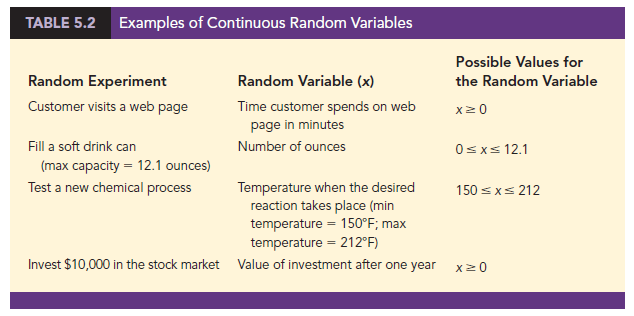A random variable provides a means for describing experimental outcomes using numer- and its associated experimen- ical values. Random variables must assume numerical values.
In effect, a random variable associates a numerical value with each possible experimental outcome. The particular numerical value of the random variable depends on the outcome of the experiment. A random variable can be classified as being either discrete or continuous depending on the numerical values it assumes.
1. Discrete Random Variables
A random variable that may assume either a finite number of values or an infinite sequence of values such as 0, 1, 2, . . . is referred to as a discrete random variable. For example, consider the experiment of an accountant taking the certified public accountant (CPA) examination. The examination has four parts. We can define a random variable as x = the number of parts of the CPA examination passed. It is a discrete random variable because it may assume the finite number of values 0, 1, 2, 3, or 4.
As another example of a discrete random variable, consider the experiment of cars arriving at a tollbooth. The random variable of interest is x = the number of cars arriving during a one-day period. The possible values for x come from the sequence of integers 0,1, 2, and so on. Hence, x is a discrete random variable assuming one of the values in this infinite sequence.
Although the outcomes of many experiments can naturally be described by numerical values, others cannot. For example, a survey question might ask an individual to recall the message in a recent television commercial. This experiment would have two possible outcomes: The individual cannot recall the message and the individual can recall the message. We can still describe these experimental outcomes numerically by defining the discrete random variable x as follows: let x = 0 if the individual cannot recall the message and x = 1 if the individual can recall the message. The numerical values for this random variable are arbitrary (we could use 5 and 10), but they are acceptable in terms of the definition of a random variable—namely, x is a random variable because it provides a numerical description of the outcome of the experiment.
Table 5.1 provides some additional examples of discrete random variables. Note that in each example the discrete random variable assumes a finite number of values or an infinite sequence of values such as 0, 1, 2, . . . . These types of discrete random variables are discussed in detail in this chapter.
2. Continuous Random Variables
A random variable that may assume any numerical value in an interval or collection of intervals is called a continuous random variable. Experimental outcomes based on measurement scales such as time, weight, distance, and temperature can be described by continuous random variables. For example, consider an experiment of monitoring incoming telephone calls to the claims office of a major insurance company. Suppose the random variable of interest is x = the time between consecutive incoming calls in minutes. This random variable may assume any value in the interval x > 0. Actually, an infinite number of values are possible for x, including values such as 1.26 minutes, 2.751 minutes, 4.3333 minutes, and so on. As another example, consider a 90-mile section of interstate highway I-75 north of Atlanta, Georgia. For an emergency ambulance service located in Atlanta, we might define the random variable as x = number of miles to the location of the next traffic accident along this section of I-75. In this case, x would be a continuous random variable assuming any value in the interval 0 < x < 90. Additional examples of continuous random variables are listed in Table 5.2. Note that each example describes a random variable that may assume any value in an interval of values. Continuous random variables and their probability distributions will be the topic of Chapter 6.


Source: Anderson David R., Sweeney Dennis J., Williams Thomas A. (2019), Statistics for Business & Economics, Cengage Learning; 14th edition.

30 Aug 2021
31 Aug 2021
28 Aug 2021
30 Aug 2021
28 Aug 2021
31 Aug 2021